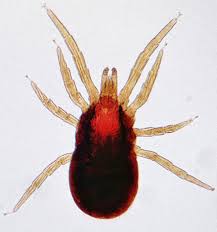
From the Middle English meaning very small or Middle Dutch meaning small copper coin, we get the term mite. Mites are small arthropods (joint-legged animals like insects, crayfish, and spiders) belonging to the class Arachnida (spiders and allies). Most mites are tiny, less than 1 mm in length, and have a simple, unsegmented body plan. Their small size makes them easily ignored; some species live in water, many live in soil as decomposers, others live on plants, while others are predators or parasites. Most species are harmless to humans but a few are associated with allergies or may transmit diseases.
There are several species of bird mites that are parasites on birds and usually found on birds’ nests. They suck the blood of birds, extracting the protein. Migration by bird mites is common when baby birds leave the nest. If the bird nest is built on or near human habitation, mites that migrate away from the nest might be found anywhere in the buildings. Sparrows, starlings and pigeons are most often associated with bird mite infestations in buildings.
Bird mites can briefly live without an avian host, but they can make their way indoors where they can crawl on and attempt to bite humans and pets. You can recognize them as jittery pepper flakes. While the mites can be an itchy nuisance, they are unable to survive on humans or in homes for any length of time, usually a matter of weeks only under ideal conditions. In most cases survival is limited to a few days, especially in a home with air conditioning. Bird mites can bite humans but are not a health threat; mostly a nuisance. Bird mites do not attack nor harm food, plants or anything else although they infect poultry and might infect pet birds.
If mites are found, removing the bird nest once the birds have left is the single most crucial step. Drying out is probably the biggest threat to bird mites, so running an air conditioner and/or dehumidifier may help. Vacuuming, using sticky tape or wiping up mites with a damp soapy cloth can all help eliminate any additional stragglers that made it inside.
Besides the skin mites that suck blood, there are also feather mites. Once thought to eat feathers, “feather mites help to remove bacteria and fungi from the feathers of birds, according to a new study by University of Alberta biologists. In fact, the relationship between these mites and their hosts could be considered mutualism, with bird feathers collecting food for mites to eat and mites providing the birds with healthier plumage.” From Science Daily

The common explanation for bald Northern Cardinals, which are occasionally sighted bald or nearly so is that feather mites were the cause. But examination of these birds yielded no or few mites. The general conclusion now is that this is just an unusual molting pattern. That fits with the new information on feather mite foods.
I’ve not been able to find out if wild birds survive if they have mites. For weeks I have watched (from a window) a mother sit on 4 eggs, watched as they they grew and are ready to leave the nest. However, I noticed that they spend most of the day picking at their bodies. Read that it’s mites. Will they survive after they leave or will the mites eventually kill them? I feel so bad for them. I call them my grandbirds.
Mites are a nuisance but not necessarily harmful to the birds. They may be preening themselves rather than picking at mites as feather care is important at this staa=ge.
https://pubmed.ncbi.nlm.nih.gov/33806588/
https://www.researchgate.net/publication/271598452_Human_Infestation_with_Dermanyssus_gallinae_Acari_Dermanyssidae_in_a_Family_Referred_with_Pruritus_and_Skin_Lesions
You are wrong and this information should be updated. Mites, can, do and will infest humans.
I did not say that mites didn’t infect humans. I did make some changes to clarify, though.
I’m curious how the family handles their birds. Do their birds reside in their home? Or outside, away from their home?